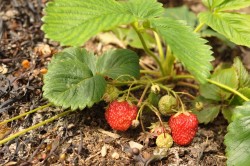Preserving America’s Food Traditions
Posted in Exhibitions, Programs and Events, The Edible Garden on August 12 2009, by Plant Talk
Learn How You Can Help
 |
Jenny Trotter is the Associate Director of Biodiversity Programs at Slow Food USA. When not at work this time of year, you’ll find her in her kitchen pickling something or experimenting with the week’s Community Supported Agriculture veggies. |
Have you ever heard of the Green Newtown Pippin apple? It was first picked on a farm around 1730 in a place we now call Queens. Thomas Jefferson grew it at Monticello and from Paris told James Madison, “They have no apple here to compare with our Newtown Pippin.” But despite its versatility and wonderful flavor, the Newtown Pippin—like hundreds of unique apple varieties—has lost the fight for shelf space to the picture-perfect but mealy and bland Red Delicious.
 The Marshall Strawberry (pictured here) tells a similar tale. Did you know that this Massachusetts berry—dating back to 1890—was known as “the finest eating strawberry in the United States?” But as of five years ago, it was on the verge of extinction.
The Marshall Strawberry (pictured here) tells a similar tale. Did you know that this Massachusetts berry—dating back to 1890—was known as “the finest eating strawberry in the United States?” But as of five years ago, it was on the verge of extinction.
These are stories that will be told at the August 20 Edible Evening, “Preserving America’s Food Traditions.” I’ll be moderating a discussion, Restoring Heritage Varieties to Our Tables, about how home gardeners, orchardists, farmers, and chefs are all playing a role in conserving rare and place-based fruit and vegetable varieties…and how you can, too.
There are many reasons why we should care about preserving these foods, and it’s not because we’re nostalgic for the past or because of taste alone. Many people are starting to realize that our current fuel-intensive, globalized food system is not stable or secure enough to keep feeding us. In a Leopold Center for Sustainable Agriculture survey last year, only 15 percent of those surveyed felt assured that the global food system is safe anymore. Nearly three-quarters of the respondents felt that local and regional food systems would be more reliable in meeting the future nutritional needs of Americans. But to re-localize our food systems, we need each region to grow the grains, vegetables, fruits, and meats adapted to that climate rather than getting all our fruits from California and our beef from the Great Plains. Sadly, by sheer neglect of their value, we have put at risk nearly two-thirds of all the place-based heritage foods remaining on this continent that are adapted to regional climates, soils, and cultural traditions.
It’s time to bring the biological wisdom of these diverse foods back to our fields and our tables. And to do so, we need to value and support the farmers, ranchers, fishers, foragers, and orchard-keepers who are keeping the remaining diversity of our place-based foods alive. It’s important to promote local and seasonal eating, but we also must re-invest in the diversity of seeds and breeds historically adapted to American places and in the food producers growing and raising these foods.
At Slow Food USA, we encourage people to pick up their forks to eat, and thus help revive, endangered varieties and to start projects to identify and recover the foods that are important to their communities. Around the country, through grassroots initiatives, people are discovering almost extinct varieties, like the Bodega Red Potato, and alternative food distribution models that directly support farmers, like Community Supported Agriculture (CSA). There’s even a new CSA in Maine focused solely on introducing people to the diversity of apples in their region.
Here are some ways that you can personally get involved:
- Learn about the foods that were historically grown in your region and grow them in your garden, with children at a local school, or on your farm to see what grows well.
- Encourage and support farmers who grow a diversity of seeds and breeds.
- Become a seed saver or fruit explorer and organize seasonal events to exchange great varieties with others in your community.
- Host a dinner or picnic to feature regional foods.
- Organize a field trip to seek out rare foods in your area.
- Encourage a local restaurant to feature heritage foods on their menu.
- Nominate an endangered food from your region to the Ark of Taste if it has a great story, great taste, and market potential.
- Start a recovery project for an endangered food or production method.
- Join Slow Food USA and become active in your local chapter.
Come down to The Edible Garden on August 20 and let the stories transport you to backyard gardens and abandoned orchards and if nothing else, introduce you to tasty fruit varieties that you can help save and seek out at your local farmers market. The fall months are right around the corner, and soon we can start peeling apples—Green Newtown Pippins, perhaps—and filling our kitchens with aromas of sweet chutneys and homemade applesauce.

